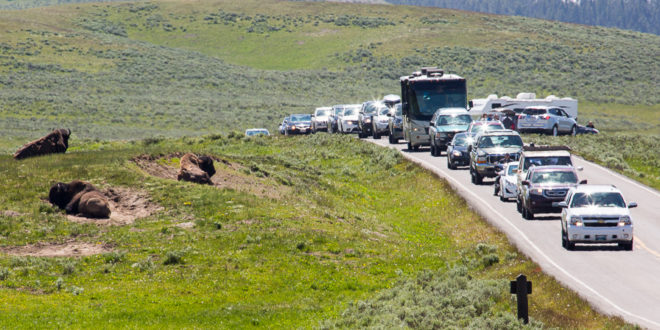Yellowstone National Park has released a pair of studies analyzing traffic and parking as well as visitor experiences and values.
According to a Yellowstone press release, the reports, commissioned for 2016, analyze how visitor traffic has changed since 2008 and what it means for the future of the park.
Visitation to Yellowstone has been on a noticeable rise since 2008. Indeed, 2016 saw a little over four million people streaming through the park. Just this week, we reported July 2017 was the third busiest on record.
The uptick in visitors is also straining Yellowstone’s infrastructure. Indeed, officials have mulled implementing vehicle caps and shifting traffic away from individual vehicle and toward shuttles and buses. From the Yellowstone press release:
“Historic and recent trends demonstrate that visitation will increase over the long-term, therefore, it is imperative for us to plan now,” said Superintendent Dan Wenk. “Good visitor use management will allow the park to protect resources, encourage access, and improve experiences.”
The new data from the Visitor Use Study shows that visitors enjoy and care about Yellowstone, but they think it’s too crowded during the summer season. Visitors value the park for its natural character and come specifically to experience scenery, wildlife, thermal features, a largely intact ecosystem, and sounds of quiet and nature. More than half of Yellowstone’s visitors surveyed think that there are too many people in the park. Based on data collected in the study, 83 percent of Yellowstone’s visitors come from the United States and 17 percent come from abroad, including visitors from Europe (49 percent of international), China (34 percent of international), and Canada (10 percent of international).
The Transportation and Vehicle Mobility Study shows that within Yellowstone’s most heavily-travelled corridors, parking lots are overflowing, traffic jams abound, and roadway safety incidents are on the rise. The report identifies the busiest corridors as the roads that connect Yellowstone’s West Entrance with visitor attractions throughout the western and central parts of the park (such as Old Faithful, other geyser basins, the Canyon Area, Hayden Valley, Fishing Bridge, and Lake Village). During much of the summer season, there are on average nearly 30 percent more vehicles using these corridors than those roads can comfortably and safely handle.
Outside of heavily-travelled corridors, traffic levels are also high, with vehicles following closely behind other vehicles 60-80 percent of the time. According to the study, assuming a conservative 3.7-5.3 percent growth rate per year, all roadways in the park are expected to perform poorly by 2021-2023 due to traffic volume. Two thirds of Yellowstone’s visitors surveyed think that finding available parking is a problem, and over half think that the amount of roadway traffic and congestion are problems.
The data from these two new reports, combined with internal data about resource impacts, will help Yellowstone managers consider the types of management strategies that could be used in the future. These strategies include (but aren’t limited to) communication and traffic management systems, shuttle systems and other types of transportation alternatives, and reservations or timed-entry systems. These strategies could be implemented in key locations or park wide.
Other studies have reached similar conclusions to those above. Indeed, a recent study from the University of Montana concluded overcrowding has a detrimental effect not only in Yellowstone but parks like Glacier. The UM report notes that getting more “boots on the ground” and shifting attention to other attractions (like the National Bison Range or West Yellowstone’s Grizzly & Wolf Discovery Center) could benefit park infrastructure.
Yellowstone plans to continue gathering information about traffic and visitor use through 2019. Said studies will be used to guide future management policies for Yellowstone National Park. You can see the two reports in full here.
 Yellowstone Insider Your Complete Guide to America's First National Park
Yellowstone Insider Your Complete Guide to America's First National Park





